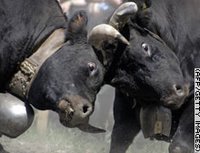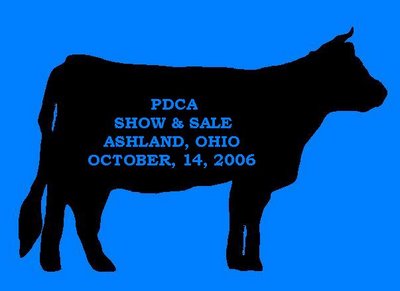What to Look for:
Your future success with grassfed beef production hinges on 3 things:
Access to quality pasture
Management abilities
Genetics
There are plenty of good resources on the web for the first two items, so on this Grass-fed beef genetics webpage we'll cover in detail the nuts and bolts (or is that the D's,N's and A's ?) of genetic selection.
Size, Bloodlines, Environment, How are they raised?
1. Size. Size does matter, and less is more. You want your breeding stock to be below a 4.5 frame score, ideally somewhere between 3-4.5.
So, what is a frame score? Frame scores are the measurement of the animal's hip height charted against a given age. Thus you can measure an animal's hip height at 11 months of age (charts are gender-specific) and if he measures a 4, he will still measure a 4 at 18 months or 24 months of age.
For a printable frame score chart as well as detailed information about frame scores, visit: http://www.ext.nodak.edu/extpubs/ansci/beef/as1091w.htm
Now, why do we care about frame scores and hip heights? Because these are practical, objective tools at our disposal to better predict the ability of an animal to function in a grass-fed beef program. They do this by helping us to assess the likely mature weight of the young cow or bull, and the probable weight at maturity of their offspring. These are vital parameters for the grassfed beef producer. As grassfed beef producers, we need early maturing cattle, typically the lower frame score cattle.
You do not want animals that are going to mature at 1400 pounds! The time required to finish this on forage alone will put him well beyond 3 years of age. Not only will meat quality be affected, but your bottom line will be also. In terms of turnover, how long can you afford to have cattle around using up pasture resources before they convert into cash flow for your operation?
There is also an economic incentive for keeping those 'short, squatty' cows around: they tend to be easy keeping. Which model gets better gas mileage, a Hummer or a BMW? Its no different with cows: bigger cows have much higher energy requirements, and their ability to be productive, i.e. breed, birth, milk and re-breed in a low input system, is greatly impaired.
2. Bloodlines: No, we're not interested in fancy pedigrees, but we are keen on knowing the body type of our prospective breeding stock's ancestors. Why? It has to do with prepotency. Prepotency is the ability of a parent to consistently pass along its characteristics to its offspring. A single frame score 4 animal that suddenly materializes out of a herd of frame 5-6 cattle is very unlikely to be prepotent for this frame score and maturity type. Using such an animal, particularly if it is a bull, you run a high risk of many 'throwback' calves, calves that are representative of the true gene pool of the herd that produced the bull in the first place.
Continued, (part2)















